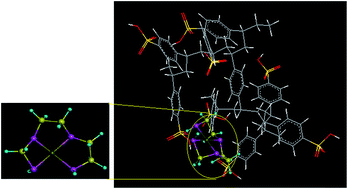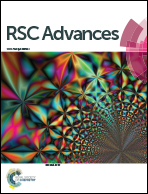Copper selective self-sorting polymeric resin with mixed-mode functionality for column preconcentration and atomic absorption spectrometric determination†
Abstract
A new approach for the synthesis of a highly Cu(II) selective mixed-mode solid phase extractant is proposed. In aqueous medium triethylenetetramine (trien) reacts with Dowex 50 resin and forms a self assembled product. The self-sorting trien molecules get attached by forming a hydrogen bond with the sulfonic acid groups of the resin, where nitrogen-containing functional groups flexibly change their orientation in order to selectively coordinate with Cu(II) in a square-planar geometry. This enables the solid phase to behave in a manner similar to a free monomeric ligand in a liquid–liquid system. A column procedure for preconcentration/separation of Cu(II) was developed optimizing various experimental variables which exhibits a low preconcentration limit (3.3 μg L−1) and high sorption capacity (101.6 mg g−1 of resin). An analytical method coupling column preconcentration procedure with flame atomic absorption spectrometry (FAAS) was validated analyzing standard reference materials and recovery of the spiked analyte. The proposed method was successfully applied for the preconcentration and determination of Cu(II) in tap water, river waters, electroplating wastewater, and a tea sample.


 Please wait while we load your content...
Please wait while we load your content...